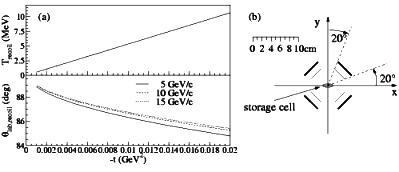Conceptual Design
To reveal rare reactions like the Drell-Yan process and the pbar p → e+e annihilation, the PAX detector has to be conceived as a large acceptance apparatus capable of unambiguously identifying electron-positron pairs of large invariant mass and precisely measuring their momenta. A clear particle identification is required to separate the electrons of the wanted processes from the large pion background. Reactions characterized by two-body hadronic final states like elastic scattering, present a higher cross-section and put less stringent constraints on the detector design. They can be identified by measuring scattering angles and momenta of the hadronic particles by employing coplanarity and total momentum conservation.
Since a definite choice has not been made yet on the accelerator configuration (fixed target or collider), at this stage is not possible to define the detector details. What we present here is just meant as a conceptual detector design suitable for the PAX physics program. Once the PAX experiment is approved, each of the detector componentss will be further optimized depending on the chosen beam configuration. The performance of the detectors will finally depend (and benefit) from the development in technology over the course of the next ten years. The present conceptual detector design is based on existing experiments which have been proven to perform well measuring final-state particles and energies similar to the ones anticipated at PAX.

Fig. 1. |
A threshold Čerenkov counter (CER) provides trigger capability for electrons and positrons produced in Drell-Yan processes. Electron and photon energies and directions are measured by the CAL. Both the CER and the CAL provide fast response and can be employed in the selection of electromagnetic particles to obtain a π/e rejection factor ≤ 100 at trigger level and larger than 104 in the off-line analysis for a single track.
The central detector is designed to assure full acceptance between ±200 and ±1300 for polar angles in the laboratory frame. It is not active in the small sectors of azimuthal angles in correspondence of the toroid coils. In these sectors the service systems for the detectors and the support structure of the system can be mounted. In the present design, no real limit exists for the maximum acceptable polar angle: the above values can be taken as indicative for the collider option and can be easily adapted to match different beam configurations. The detectors point toward the central part of the interaction region in a projective geometry.
An internal reflecting ring-imaging Čerenkov counter (DIRC) can be employed to identify charged hadrons (pions, kaons and protons). This provides flavor separation in single- spin asymmetry investigations, as well as in the analysis of other semi-inclusive and exclusive channels.
 Fig. 2. |
The particle identification of the forward spectrometer has to be adapted to the chosen beam configuration. The sensitivity on the transverse distribution h1 in the forward direction is poor, because âTT is small there. In the asymmetric collider mode, Drell-Yan events with scattering angles below 200 in the laboratory frame basically do not improve the statistical precision of the h1 measurement. The forward region will be crucial for the SSA measurements at high energy and large values of xF, so that the forward particle identification has to be optimized for hadrons. One promising option is to make use of a RICH detector. For a fixed-target experiment with 22 GeV/c beam momentum, the lower limit of the useful scattering angle reduces to 50 due to the relativistic boost. The PID of the FS has to be optimized for electron detection like the LAS.
Recoil Detector. A silicon recoil detector system is needed for the low-t antiproton- proton elastic scattering program and will only be installed for these measurements, so that radiation damage will be a minor issue.
At very low momentum transfer (|t| = 0.002 ... 0.02 GeV2) the recoil protons are detected by silicon strip detectors close to 900 laboratory angle. At these angles (Fig. 3a) the protons of interest have energies between 1 and 10 MeV and are stopped in a telescope comprised of a 65 μm thin surface barrier detector and a 1 mm thick microstrip detector. Such a telescope has already been successfully operated in a similar environment at the ANKE experiment at COSY/Jülich. In view of the comparably large cross section (dσ/dt > 150 mb/GeV2) a precise measurement of the recoil energy is sufficient both to determine t and to cleanly identify elastically scattered protons as in the E760 experiment at FNAL.

Fig. 3 |

 Andrea Pesce
Andrea Pesce